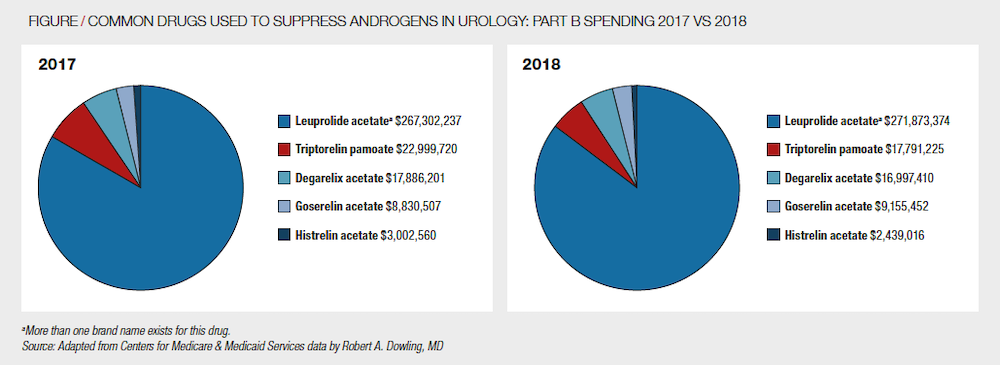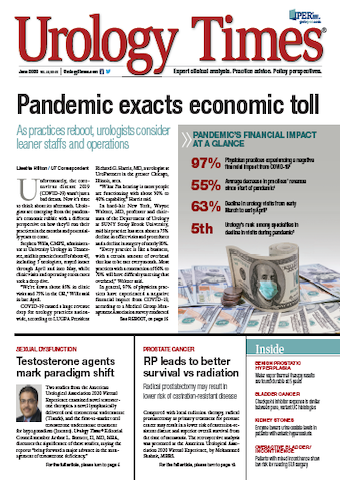Publication
Article
Urology Times Journal
Denosumab tops spending for common urology Part B drugs
Author(s):
Mitomycin sees the largest annual growth in spending per dose over the past 5 years, Robert A. Dowling, MD, reports.
Robert A. Dowling, MD

Growth in drug costs and spending for Medicare beneficiaries continues to be an area of concern for patients, policy makers, and regulators. In an article last year,1 I reported that for 7 of 16 drugs commonly administered in the office by urologists, spending increased faster than Part B drug spending overall. There have been no significant regulatory changes that have directly affected Medicare Part B drug policy in 2019. In this article, I update the spending and costs for Medicare Part B drugs commonly used by urologists in the office setting.
The Centers for Medicare & Medicaid Services recently released detailed drug spending data for the years 2014-2018 (Medicare Part B Drug Spending Dashboard. Centers for Medicare & Medicaid Services. December 17, 2019. Accessed May 11, 2020. https://www.cms.gov/Research-Statistics-Data-and-Systems/Statistics-Trends-and-Reports/Information-on-Prescription-Drugs/MedicarePartB.html). “Spending” in this context includes the estimated total costs including deductible, coinsurance, and Medicare spending. Total spending in 2018 for the Part B program was $33.3 billion, up 9.3% from 2017. Spending on any single drug may increase because of increased utilization, increased price, or both. Let’s take a closer look at some individual drugs that urologists typically use in their practice (it is not possible using these data to determine what fraction of spending is “ordered” by urologists, or the indication for any individual drug).
Of 17 common drugs used in the urology office for Medicare beneficiaries (Table), the drug with the largest 2018 total spent was denosumab ($1.42 billion). In 2018, utilization for denosumab increased 12.4%, spending per dose increased 1.79%, and total spending increased 14.39% compared with 2017. Denosumab spending has increased 4.53% per year over the past 5 years and continues to be the target of automated medical review in some areas of the country.
Common drugs used by urologists: 2018 Medicare Part B Spending

The drug with the largest annual growth in spending per dose unit among this selected group is mitomycin (54.18% annual growth over the past 5 years); spending per dose on mitomycin increased 13.4% in 2018 alone. Although overall usage of mitomycin and gemcitabine (Gemzar) declined in 2018 compared with 2017, the impact of the recent bacillus Calmette-Guérin shortage will probably result in greater utilization of mitomycin and gemcitabine in 2019 reports.
OnbotA spending up 7.1%
Among the same set of drugs, spending on onabotA was $348 million, up 7.1% over 2017 and due primarily to increased utilization. The annualized growth in spending/dose (a surrogate for price) for onabotA has been just 1.7% over the past 5 years.
In the androgen suppression market (Figure), leuprolide acetate was still the most common drug with spending in 2018 of $272 million (1.7% higher than 2017). Over the last 5 years, growth in spending per dose has decreased 1.3% annually. Spending on triptorelin pamoate decreased sharply (26%) in 2018, whereas the price of goserelin (Zoladex) rose almost 16%, increasing spending on that drug by 3.8% over 2017.
Common drugs used to suppress androgens in urology Part B Spending: 2017 vs 2018

In general, among these 17 drugs, those with 1 or 2 manufacturers have seen higher annual growth in spending per dose (a surrogate for price) and those with 3 or more manufacturers have seen lower or negative annual growth. Mitomycin is the notable exception to this rule as mentioned earlier.
The bottom line: of 17 Part B drugs commonly used by urologists, only 3 drugs increased in spending faster than Part B spending overall in 2018. The drug with the largest total spending is denosumab, and the drug with the largest annual growth in spending per dose over the last 5 years is mitomycin (54.2%). Urologists should be familiar with the average sales price and trends of the common Medicare Part B drugs administered to their patients.
Reference
1. Dowling, Robert A. CMS data reveal trends in Part B drug spending. Urology Times. 2019; 47(5):26-27






















